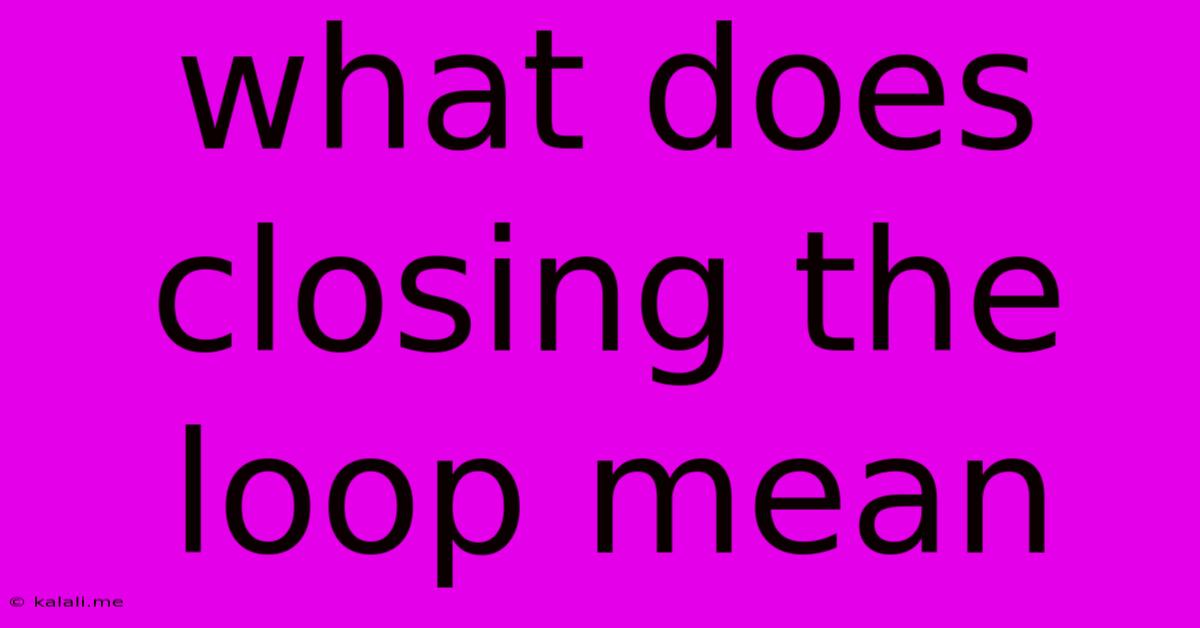What Does Closing The Loop Mean
Kalali
Jun 03, 2025 · 3 min read

Table of Contents
What Does Closing the Loop Mean? A Comprehensive Guide
Meta Description: Understanding "closing the loop" is crucial for effective communication and project management. This guide explains its meaning, benefits, and how to implement it successfully in various contexts.
In today's fast-paced world, efficient communication and follow-through are paramount. A key concept in achieving this is "closing the loop." But what exactly does it mean? It's more than just a catchy phrase; it's a vital process that ensures clarity, accountability, and ultimately, successful outcomes. This article will explore the meaning of closing the loop, its applications across different fields, and the benefits it provides.
Understanding the Concept of Closing the Loop
At its core, closing the loop means completing a cycle of communication. It involves acknowledging receipt of information, providing an update on progress, and confirming the resolution of an issue or completion of a task. Think of it as a feedback loop that ensures everyone is on the same page and that nothing falls through the cracks. This simple yet powerful process prevents misunderstandings, improves efficiency, and strengthens relationships.
Applications of Closing the Loop
Closing the loop isn't limited to a single field; it's a valuable practice across various industries and contexts. Here are some key examples:
-
Customer Service: When a customer reports a problem, closing the loop involves acknowledging their issue, providing updates on its resolution, and confirming its successful completion. This leaves the customer feeling heard, valued, and confident in the company's service. It's the difference between a frustrating experience and a positive one. Think of email confirmations, follow-up calls, or satisfaction surveys.
-
Project Management: In project management, closing the loop ensures that all tasks are completed, deadlines are met, and goals are achieved. This involves regular updates, progress reports, and confirmation of successful task completion. This minimizes potential roadblocks and delays. Think of regular team meetings, task completion check-ins, or project wrap-up reports.
-
Internal Communication: Within an organization, closing the loop is crucial for maintaining clarity and accountability. This involves confirming receipt of emails, responding to requests, and following up on delegated tasks. Clear and concise communication ensures everyone is informed and working towards the same objectives.
-
Sales and Marketing: In sales and marketing, closing the loop involves tracking the effectiveness of campaigns, analyzing customer responses, and making necessary adjustments. This iterative process helps optimize strategies and improve conversion rates. This often involves A/B testing, campaign performance reviews, and customer feedback analysis.
Benefits of Closing the Loop
Implementing this process offers several key advantages:
- Improved Communication: It ensures everyone is informed and up-to-date, minimizing confusion and misunderstandings.
- Increased Accountability: It clarifies roles and responsibilities, holding individuals accountable for their actions.
- Enhanced Efficiency: It streamlines workflows, preventing delays and improving overall productivity.
- Stronger Relationships: It fosters trust and strengthens relationships by demonstrating responsiveness and care.
- Better Problem Solving: By providing a structured feedback mechanism, it allows for quicker identification and resolution of problems.
How to Effectively Close the Loop
Successfully closing the loop requires a proactive and organized approach. Here are some practical tips:
- Acknowledge Receipt: Always acknowledge receipt of information, whether it's an email, a request, or a customer query.
- Provide Regular Updates: Keep stakeholders informed about progress, highlighting both successes and challenges.
- Confirm Completion: Once a task or project is completed, confirm its successful completion with all relevant parties.
- Solicit Feedback: Encourage feedback to identify areas for improvement and enhance future processes.
- Use appropriate tools: Employ project management software, CRM systems, or other tools to streamline the process.
Closing the loop is a fundamental practice that underpins successful communication and project management. By implementing this straightforward yet powerful technique, individuals and organizations can significantly improve efficiency, enhance relationships, and achieve better results. The time investment is minimal, but the return is substantial.
Latest Posts
Latest Posts
-
How To Remove Sliding Door From Tracks
Jun 04, 2025
-
Count Equivalent In Data Table In R
Jun 04, 2025
-
Wrodpress How To Modify The Sidebar Contents
Jun 04, 2025
-
Replacing A Piece Of Drywall With Wood For Easy Access
Jun 04, 2025
-
Legal Age To Drink In Barbados
Jun 04, 2025
Related Post
Thank you for visiting our website which covers about What Does Closing The Loop Mean . We hope the information provided has been useful to you. Feel free to contact us if you have any questions or need further assistance. See you next time and don't miss to bookmark.